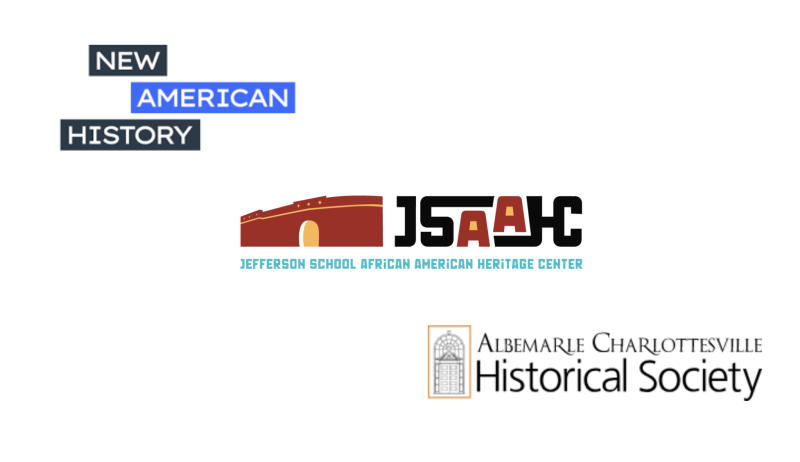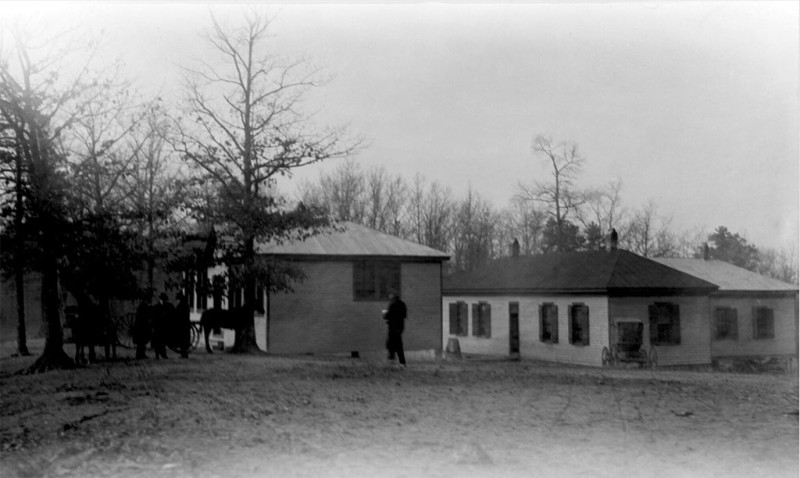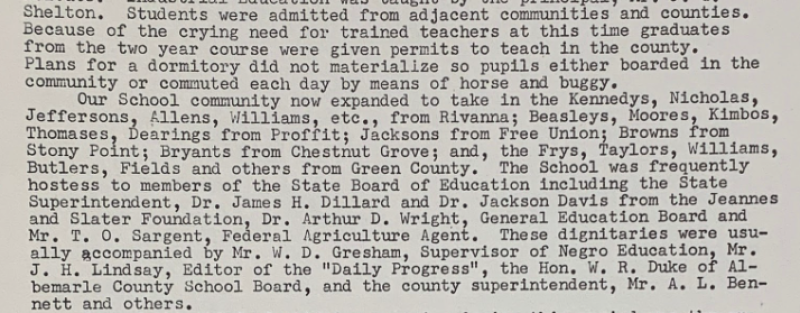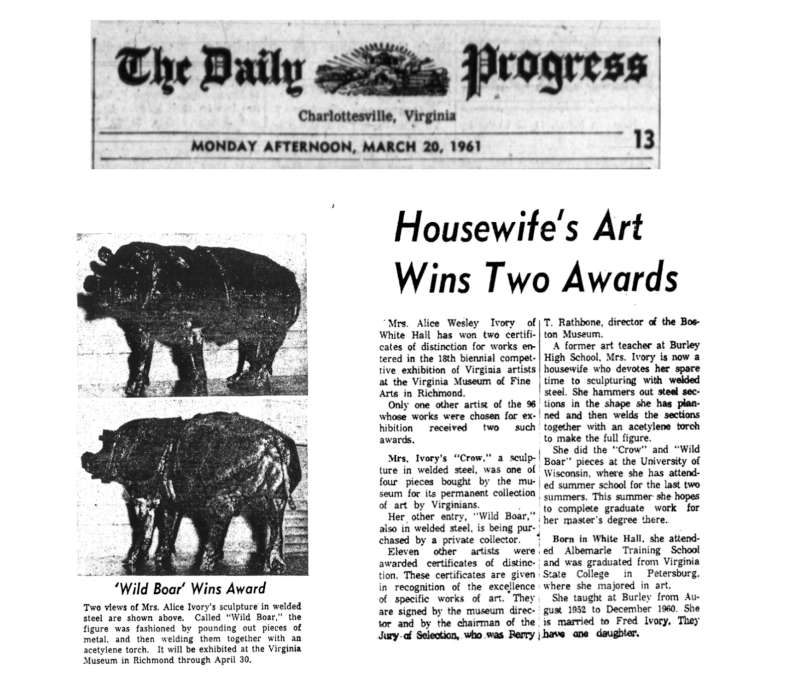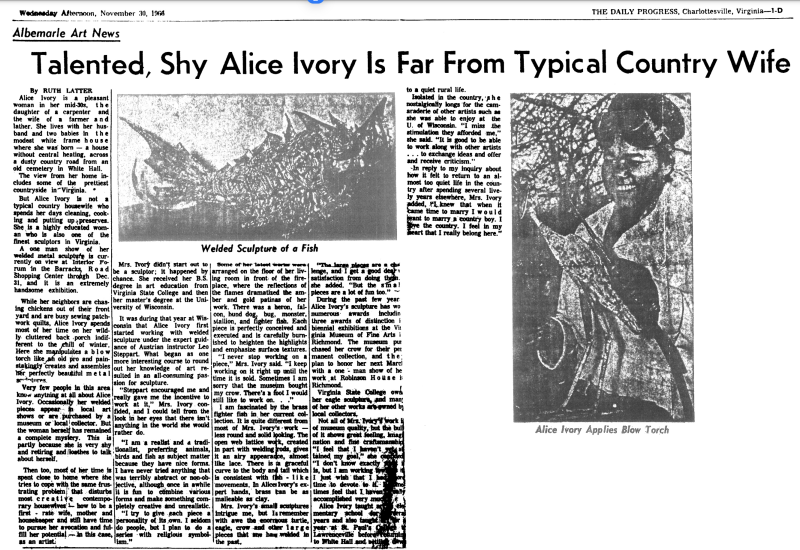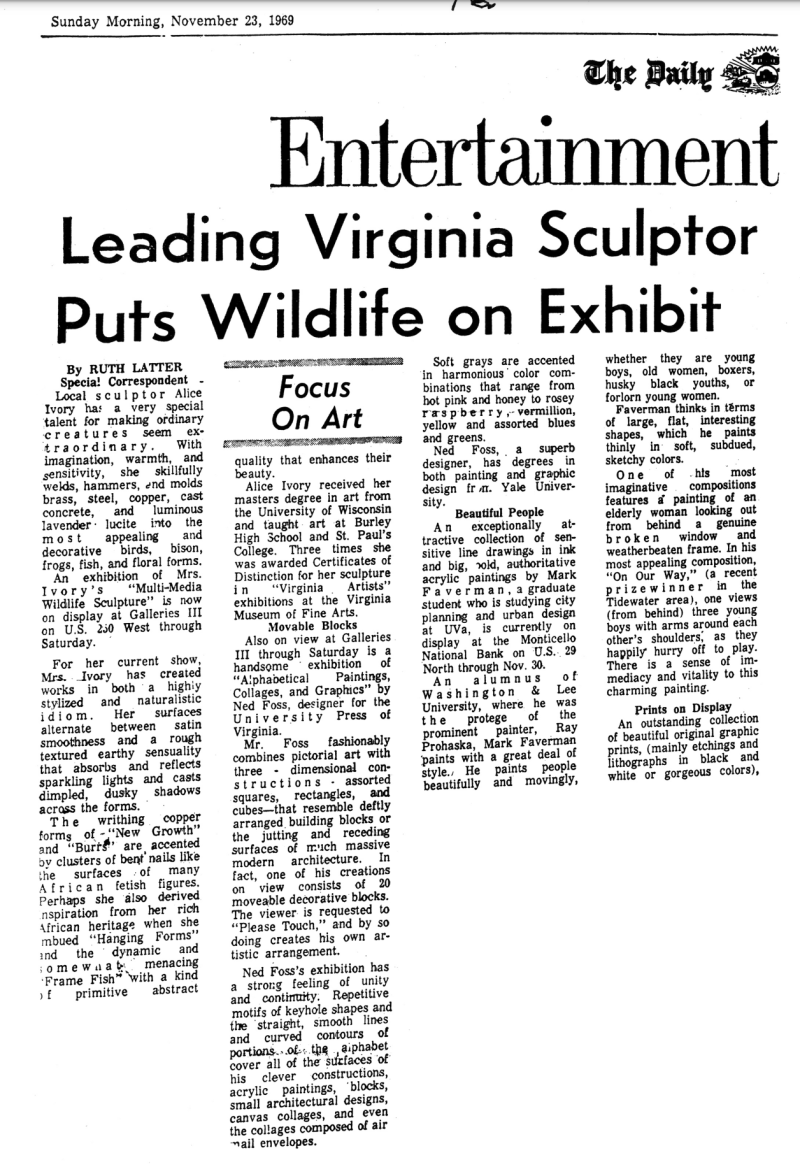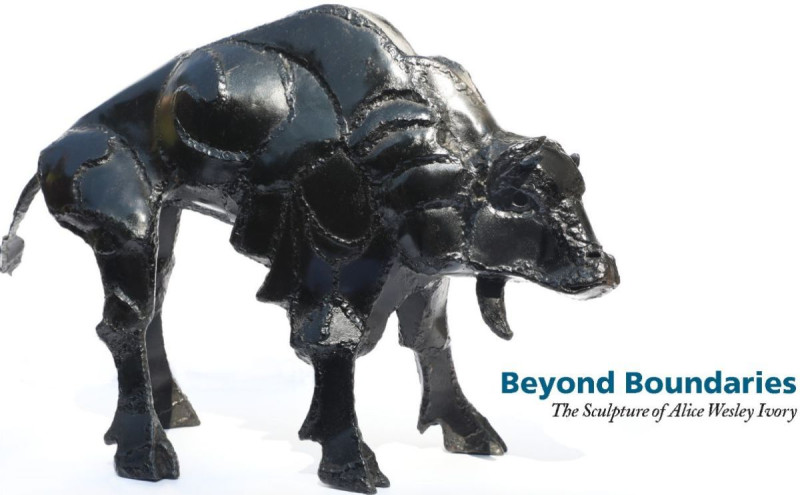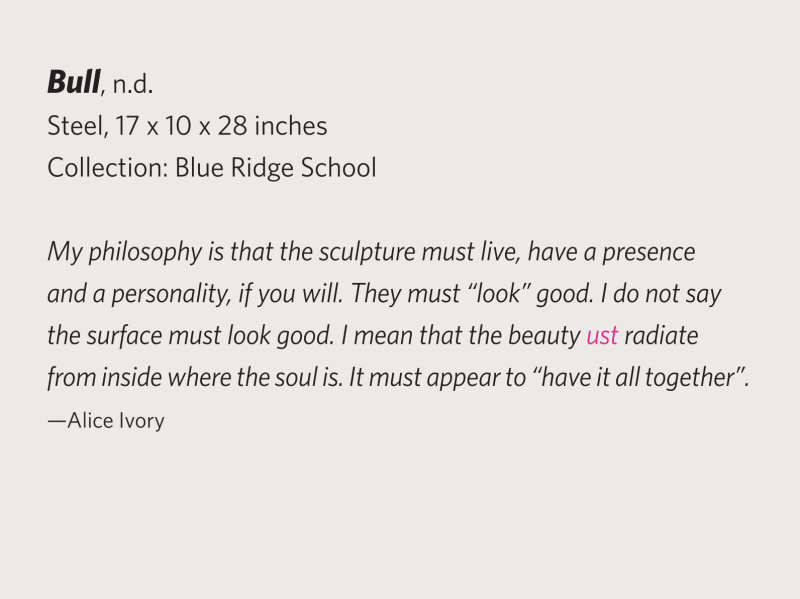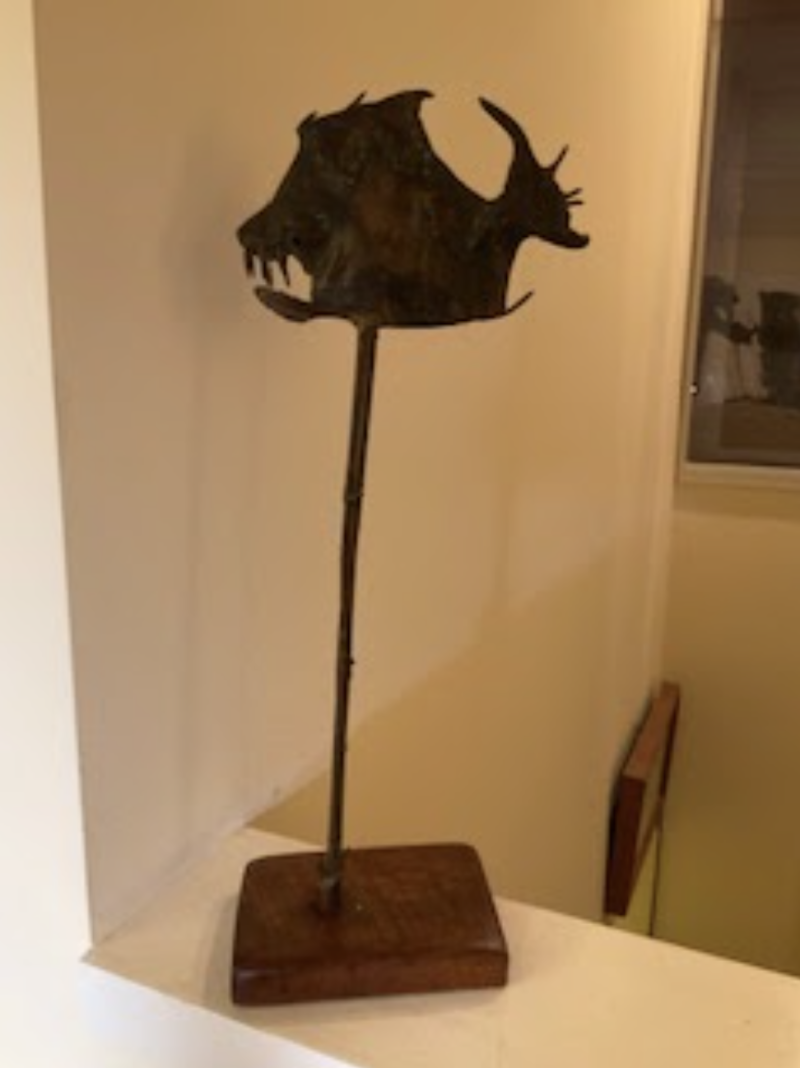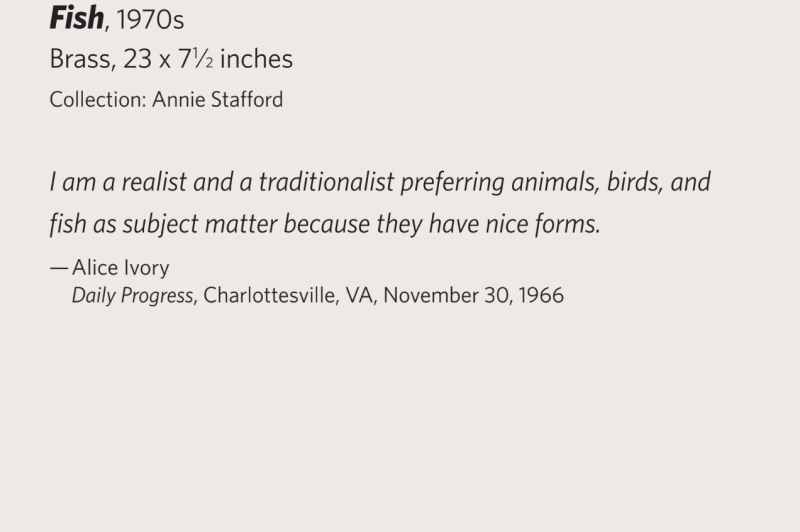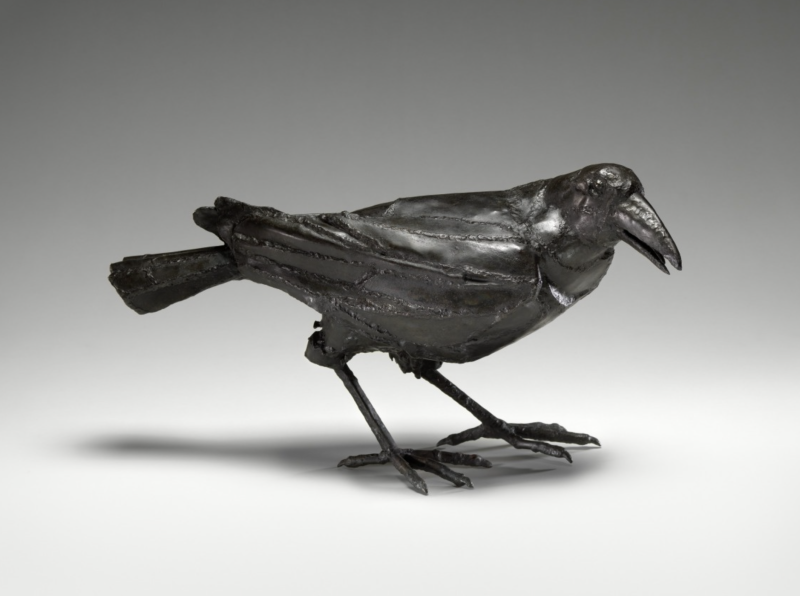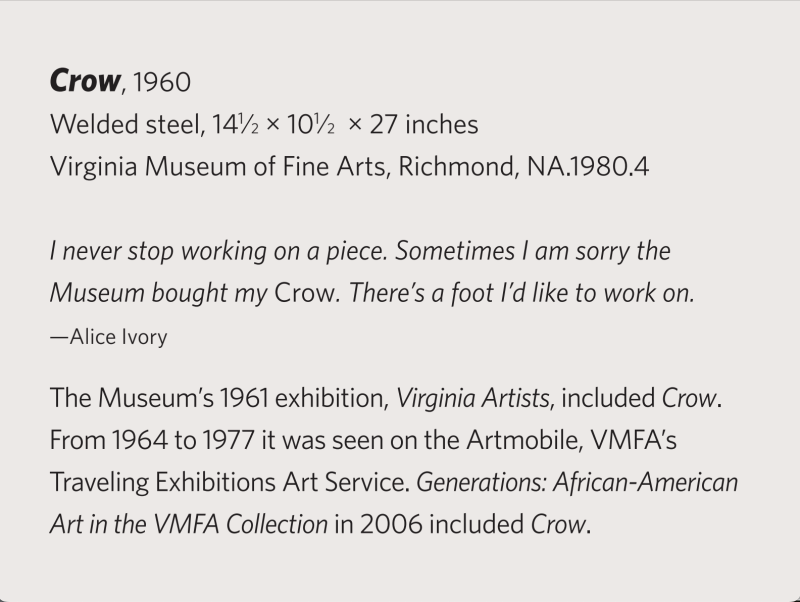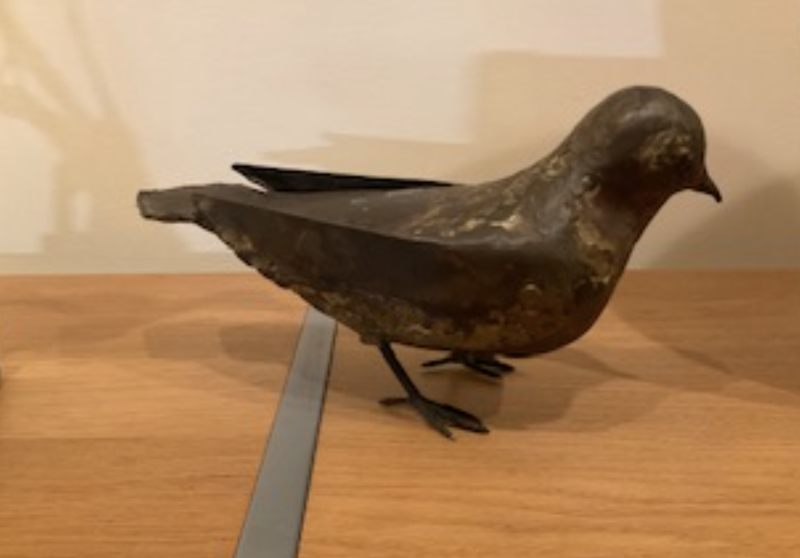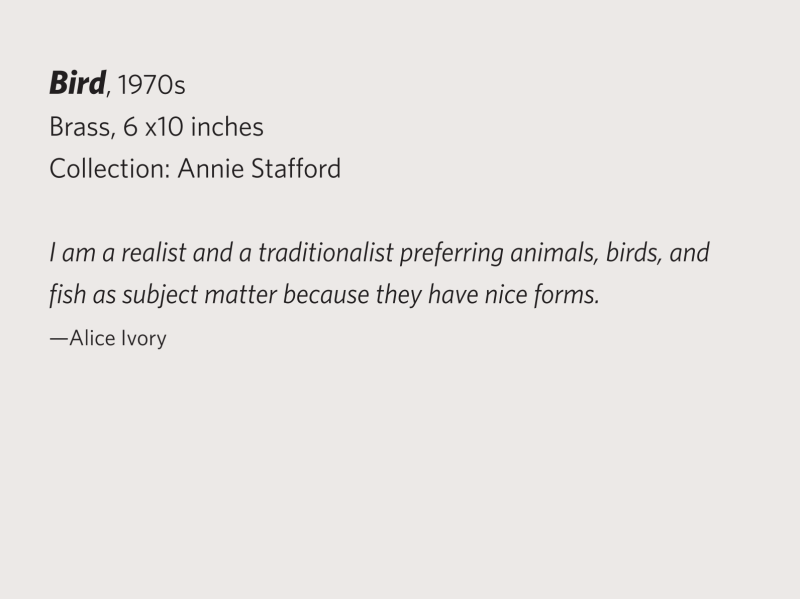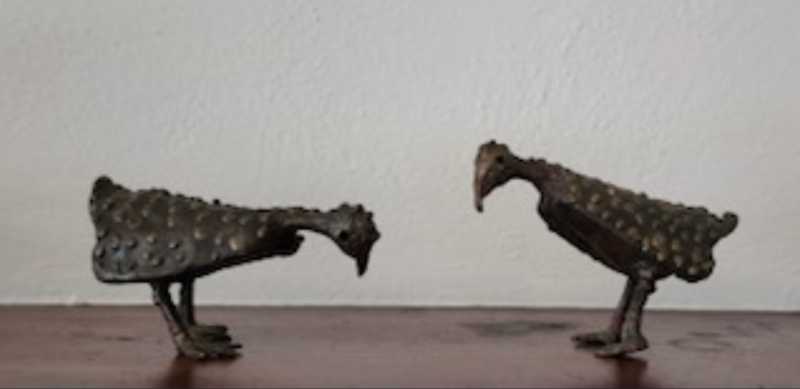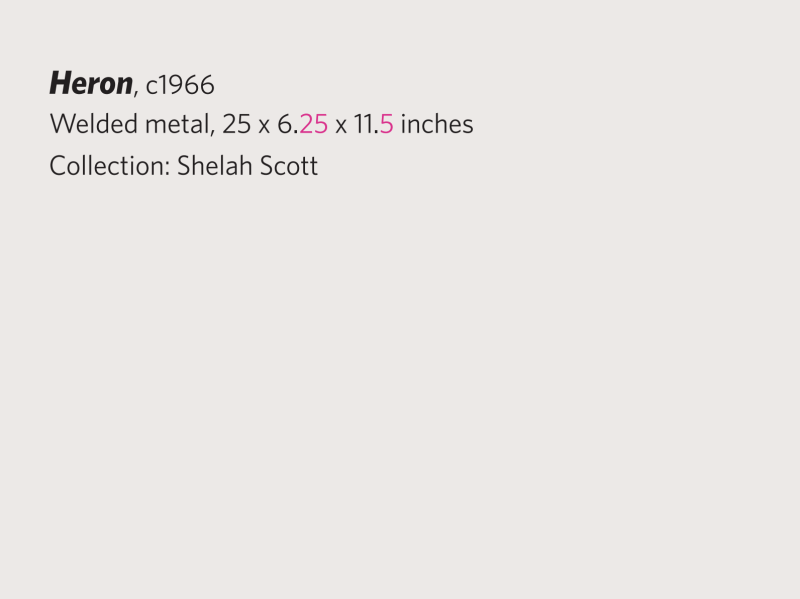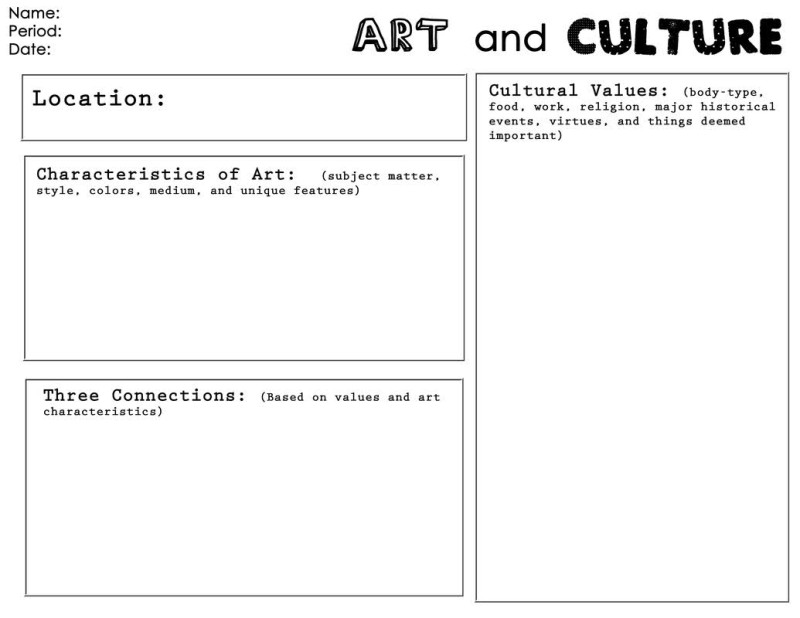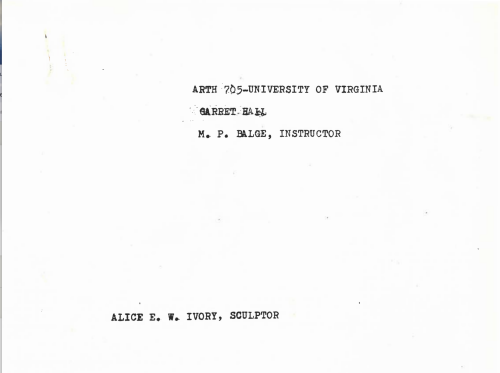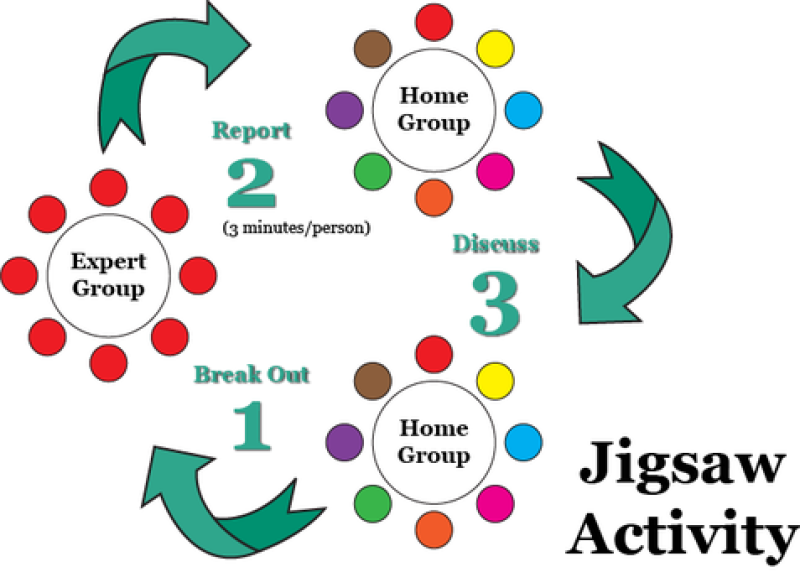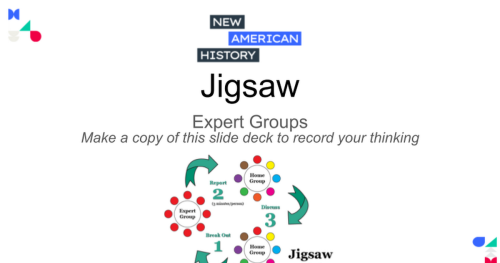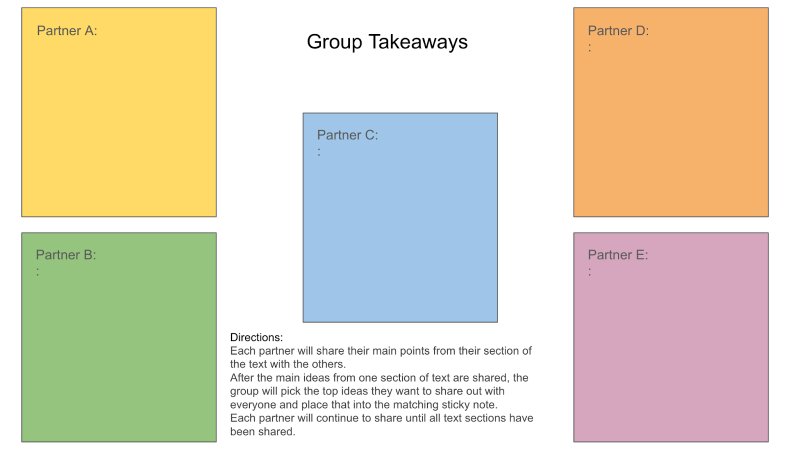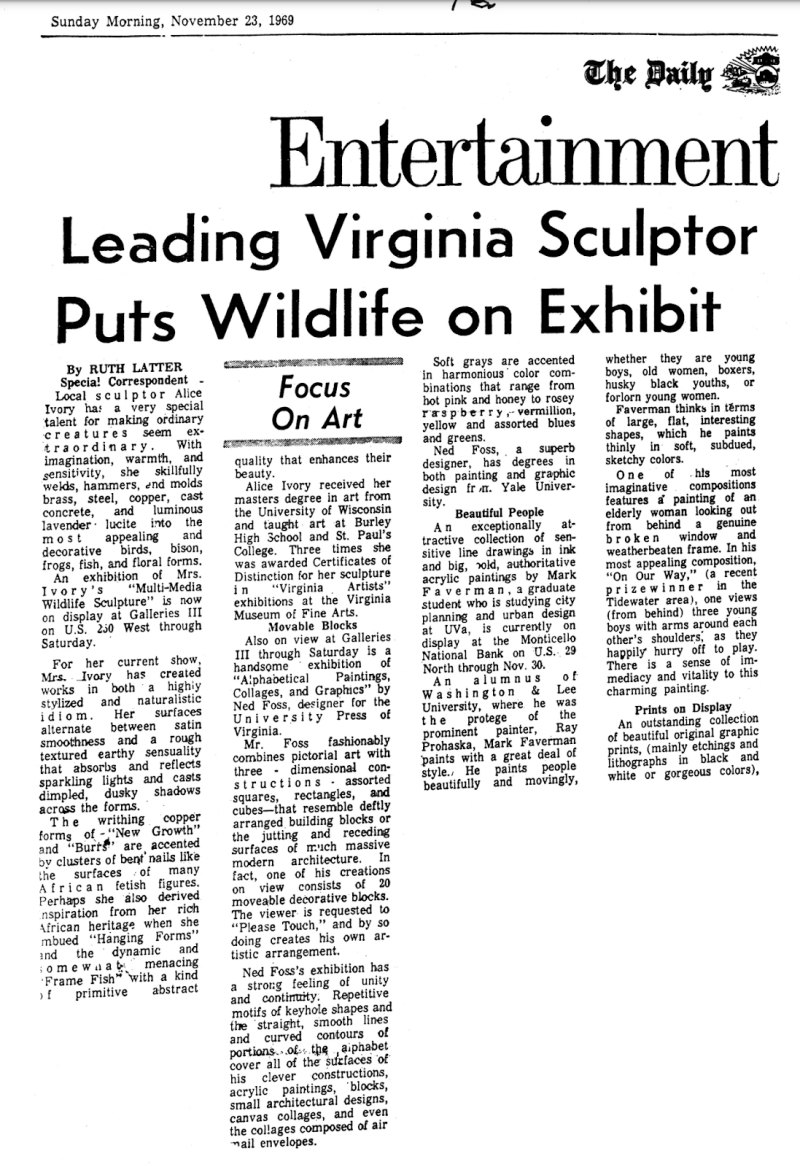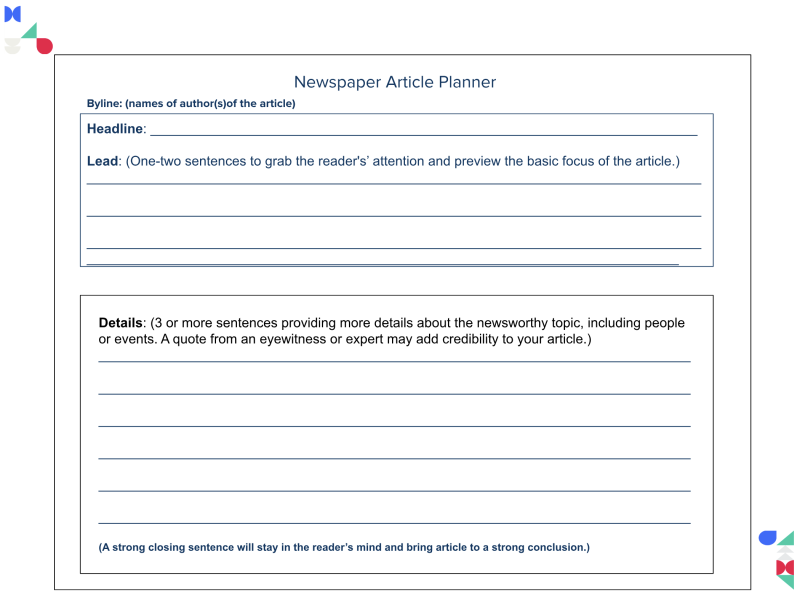This work by New American History is licensed under a Attribution-NonCommercial-ShareAlike 4.0 (CC BY-NC-SA 4.0) International License. Permissions beyond the scope of this license may be available at newamericanhistory.org.
All History is Local: Beyond Boundaries, The Sculpture of Alice Wesley Ivory
View Student Version
Standards
Virginia Standards of Learning H/SS:
VS.1c, d, g
VS.8b
VS.9c, d
US II.4c
VUS.8d
Teacher Tip: Think about what students should be able to KNOW, UNDERSTAND, and DO at the conclusion of this learning experience. A brief exit pass or other formative assessment may be used to assess student understandings. Setting specific learning targets for the appropriate grade level and content area will increase student success.
Suggested Grade Levels: 6-8, 9-12
Suggested Timeframe: Three 45-minute class periods or Two 90 minutes blocks
Suggested Materials: Internet access via laptop, tablet, or mobile device. If possible, plan a field experience to view the exhibit at the Jefferson School African American Heritage Center..
Key Vocabulary
Autobiography - a first-person account of one’s life and achievements, usually written more formally for a specific audience.
Biography - an account of a person's life, written by someone else.
Boundary - a limit or dividing line that shows or points out an end. It can also be defined as the space between you and another person and the unspoken rules of how you will treat someone and how you expect to be treated.
Child-rearing - the process of bringing up a child or children as a parent, guardian or primary caregiver.
Composition - a work of music, literature, or art. The term composition means "putting together". It can be thought of as the organization of the elements of art according to the principles of art. Composition can apply to any work of art, music, or literature that is arranged using conscious thought.
Domesticity - a 19th-century ideology that expected middle- and upper-class women to devote themselves to their home life.
Excerpt - a passage (as from a book, film, or musical composition) selected, performed, or copied.
Gender - Expected behaviors and characteristics of girls, boys, non-binary people,
Homeplace - a person's family home or birthplace, a space where people feel nurtured, comforted, and fed.
HBCUs - Historically Black Colleges and Universities - institutions that were established before 1964 with the principal mission of educating Black Americans.
Influencer - a person who inspires or guides the actions of others, someone who can persuade a lot of other people, for example, their followers on social media, to do, buy, or use the same products or businesses that they do.
Jim Crow laws - state and local laws that enforced segregation between races.
Memoir - a nonfiction narrative based on the author’s memory of a particular period in their life, written for a more general audience.
Printmaking - the activity or occupation of making pictures or designs by printing them from specially prepared plates or blocks.
Sculpture - the art of creating three-dimensional objects by carving, modeling, or casting materials.
Segregation - the practice of race-based separation in public spaces including schools, public transportation, restroom facilities, and neighborhoods; many communities in the United States were segregated for centuries, and while the Civil Rights Movement of the 1960s removed many legal barriers, some are still socially segregated.
Stereotype - a fixed belief that a person or group of people should behave, act, or think in a certain way; stereotypes are unfair and harmful.
Weld - to join together (metal pieces or parts) by heating the surfaces to the point of melting using a blowtorch, electric arc, or other means, and uniting them by pressing, hammering, etc.
Read for Understanding
Teacher Tips:
New American History Learning Resources may be adapted to a variety of educational settings, including remote learning environments, face-to-face instruction, and blended learning.
If you are teaching remotely, consider using videoconferencing to provide opportunities for students to work with in pairs or small groups. Digital tools such as Google Docs or Google Slides may also be used for collaboration. Rewordify helps make a complex text more accessible for those reading at a lower Lexile level while still providing a greater depth of knowledge.
These Learning Resources use images and text from the exhibit, Beyond Boundaries: The Sculpture of Alice Wesley Ivory, in collaboration with the Albemarle Charlottesville Historical Society and the Jefferson School African American Heritage Center. All images and text are used for educational purposes only with the permission of the curators.
Graphic Organizers for analyzing images of Alice Ivory’s sculptures are provided as a Google Slide Deck, adapted from Mrs. Limkeman’s Art Studio. A newspaper graphic organizer is also provided. You may choose to allow students to download and make a copy of these links, or print paper copies for students as needed.
The Jigsaw strategy, adapted from the Cult of Pedagogy is suggested for the Explain section. A series of graphic organizers are embedded in the text as a Google Slide Deck and may be printed for student use, or students may make a copy and respond digitally. Separate teacher and student videos for the Jigsaw activity are provided here, as well as a paper/pencil option or digital Google Slides deck shared as a template:
Videos: Jigsaw for teachers and Jigsaw for students,
Template: Jigsaw Slides
Paper/pencil option: Use chart paper and sticky notes, let students respond, and move around the room to form groups with their sticky notes.
These Learning Resources follow a variation of the 5Es instructional model, and each section may be taught as a separate learning experience, or as part of a sequence of learning experiences. We provide each of our Learning Resources in multiple formats, including web-based and as an editable Google Doc for educators to teach and adapt selected learning experiences as they best suit the needs of your students and local curriculum. You may also wish to embed or remix them into a playlist for students working remotely or independently.
Read for Understanding (for students)
Beyond Boundaries: The Sculpture of Alice Wesley Ivory exhibit celebrates Ivory’s legacy and work. She was widely known and appreciated for her creative depictions of animals, including birds, fish, and insects, and also for notable pieces produced for churches, including the steeple for Mount Calvary Baptist Church in Ivy, Virginia. Ivory was the first African American teacher to lead the Blue Ridge School’s art department and was an art teacher at the segregated Burley High School for a decade.
Engage:
In what ways did artist Alice Wesley Ivory break boundaries?
During the Great Depression, Alice Wesley Ivory was born in 1931, one of seven children. Neither parent - Warner, a farm laborer, and Gladys Frye - had attended school, yet despite hard times they owned their Virginia farm in White Hall, Albemarle County.
Alice first attended colored White Hall School to which she walked two miles and later rode a crowded bus 14 miles to Albemarle Training School. Founded in 1886, it was the only school in the five-county area educating Blacks beyond seventh grade.
In 1954, the U.S. Supreme Court ruled that school segregation was unconstitutional in Brown v. Board of Education. Under a policy of Massive Resistance, Virginia closed its public schools. Black citizens appealed; federal courts ordered schools to reopen. Albemarle desegregated in 1959 and Charlottesville in 1962.
Alice graduated from Virginia State College (now University), an HBCU, in 1952 and began teaching art at Jackson P. Burley High School for Blacks. Seeking further graduate study in arts at the University of Wisconsin-Madison, she was accepted as a "special" student,” considered likely deficient due to education at a southern all-Black college. Alice quickly proved herself, however, receiving full graduate status and earning a Master's degree in Art Education in 1962.
Explore Sifting and Reckoning, a digital exhibit from Ivory’s alma mater, the University of Wisconsin-Madison, which references Charlottesville.
Alice discovered welding when she heard popping noises made by a group of young men waging "torch war." Fascinated by the incident, she expressed a desire to weld metal. Despite faculty reluctance, Alice convinced Austrian sculptor Leo Steppat to teach her how to weld. As she began to work on Wild Boar, fellow students came to observe, placing an apple in the Boar's mouth. Impressed, Steppat noted: "Alice can really weld." Finally, during the evaluation of her graduate work, Steppat told the faculty: "This girl is a professional sculptor," noting "A novice would not have done that."
- How did Alice’s early life and schooling break boundaries?
- How might it have influenced her art?
- Where might you look for more information about Alice Wesley Ivory’s path as an artist?
Your teacher may ask you to record your answers on an exit ticket.
Explore:
What observations might we make about Alice Wesley Ivory’s art relating to everyday life, past and present?
Read the following quotes from artist Alice Wesley Ivory:
“My philosophy is that the sculpture must live, have a presence and a personality, if you will. They must ‘look’ good. . . . the beauty must radiate from inside where the soul is.”
“. . . At times, I felt, after setting little eyes right for instance, that my little creatures have communicated with me. . . . Eyes are very important for me. I feel that if I can get them right, I almost have it made."
“None of my sculpture is anatomically or biologically accurate. I sculpt things according to the mood I am in and base them on the way I feel about the subjects. The sculptures are not based on a love for the creatures. It is based on a love for beautiful form.”
Select one of the quotes to share with a classmate. Turn and Talk about the quote.
- What did you find most interesting about the artist’s words?
- What new insights did you gain about the artist?
- What are you most curious to explore about the artist’s work?
Now view the following images and description of Alice Wesley Ivory’s work from the exhibit, Beyond Boundaries. Use the blue arrows to navigate to an image of each piece of art.
Select ONE of the sculptures to view more closely and explore the information provided about the sculpture.
- Why do you think artists choose what influences their art and what they choose to create?
- What are some influences you would draw from if you were an artist?
Use the graphic organizers provided to explore your own thoughts on art and how you interact with it in your everyday life. Complete the first one on your own, and the second one with a partner (or as directed by your teacher). Your teacher may provide a paper copy or you may make a digital copy to respond.
Your teacher may ask you to record your answers on an exit ticket.
Explain:
How do biographies and autobiographies extend our thinking about a person?
Most of us have read a biography or autobiography of a famous historical figure by the time we finish elementary or middle school. Authors often add a short biography on the back of their book jackets, or speakers at a public meeting will often be introduced first with a short biography.
One way we learn about history is through reading the biographies or autobiographies of people who lived during certain time periods or historical events. Historians often use letters and diaries as well as archival records and newspapers to piece together the life of a historical person. One famous example would be the Diary of Anne Frank, a young Jewish girl who grew up during the time of the Holocaust.
Autobiographies give readers a front-row seat to the lives and thoughts of notable people in history, or more modern figures in the arts and pop culture, in their own words. You may also find you will enjoy reading a memoir, usually a shorter text written by an author in a more informal tone, focusing on a shorter time period or events in their lives or careers.
Your teacher may ask you to read an excerpt from this text, authored by Alice Wesley Ivory in 1988 when she was a visiting artist for an Art History class at the University of Virginia, presented as a short autobiography of her life and career. Artifacts including images, historical newspaper clippings, and other documents are included at the end of the text and may be reviewed to gain additional insights into the author’s life and her thoughts about art, teaching, and society at the time of her writing.
The Jigsaw strategy may be used by your teacher to divide the text into sections.
These Google Slides provide graphic organizers to help you and your classmates capture your thoughts and participate in the discussion. Your teacher may choose to provide a paper copy, or you may make a digital copy of the slide deck to respond.
Your teacher may ask you to record your answers on an exit ticket.
Elaborate:
In what ways did Alice Wesley Ivory defy stereotypes of gender and homeplace making?
In her 1988 autobiographical essay you previously explored, Alice Wesley Ivory wrote about life as a wife, a mother, an artist and a homemaker.
Read the following excerpts from her autobiographical essay.
Excerpt 1:
Excerpt 2:
- How does Ivory describe her life as it relates to being a wife and mother?
- How does Ivory describe her life as it relates to being an artist?
- How does she describe finding a balance between her work and her career?
- Does this seem different than most women in the modern era?
In the essay Ivory included images of several personal documents including her birth certificate, marriage license, and various educational certificates and diplomas. She also included newspaper clippings from the local Charlottesville community newspaper, The Daily Progress. Take a few minutes to skim the headlines and images of the first two articles.
- What do you notice?
- What questions do you have about the headlines?
- Do the images and their captions provide any further information to help you understand more about the artist?
Now skim the article to read more about Ivory and how the local press covered her story in The Daily Progress.
- Locate the date each article was written, if available.
- Does the date provide more context for the way the newspaper described the artist and her work?
Now look at this third article written about Ivory’s exhibit at the Virginia Museum of Fine Art in Richmond, VA. Compare the headline to the headlines of the previous articles you read.
- What do you notice?
- How does the language in this headline compare to the language in the other two articles?
- What might explain any differences?
- If the Daily Progress were to write an article about Alice Wesley Ivory today, what might it say?
Turn and Talk to a partner. Create a new headline for one of the first two articles that might better reflect the artist and her work. Your teacher may provide time for you to share your headlines in small groups or lead a class discussion about the articles and their content.
Your teacher may ask you to record your answers on an exit ticket.
Extend:
Who are the modern-day artists, thinkers, and influencers you admire who are breaking boundaries today?
After exploring the words and art of Alice Wesley Ivory, think about the modern-day artists, thinkers, and influencers whose work you most admire.
- How does their work inspire you?
- How might their life experiences contribute to their art or work?
- In what ways are they, too, breaking boundaries?
- What might a headline look like about this person if it were written in the same era as Alice Ivory Wesley?
Draft a brief headline and short article/blurb about the person you selected, explaining how you see them breaking boundaries and inspiring your generation and the next.
Your teacher may ask you to record your answers on an exit ticket.
Citations:
“#archiveshashtagparty: Mary Carr Greer & the Albemarle Training School.” Notes from Under Grounds; the blog of the Albert and Shirley Small Special Collections Library , February 5, 2021. https://smallnotes.library.virginia.edu/2021/02/05/archiveshashtagparty-mary-carr-greer-the-albemarle-technical-school/.
“Albemarle Training School.” Ivy Creek Foundation. Accessed September 17, 2024. https://ivycreekfoundation.org/albemarle-training-school.
Daugherity, Brian J. (Contributor) “Desegregation in Public Schools.” Encyclopedia Virginia, September 11, 2024. https://encyclopediavirginia.org/entries/desegregation-in-public-schools/.
Heinemann (Contributor), Ronald L. “Great Depression in Virginia.” Encyclopedia Virginia, December 7, 2020. https://encyclopediavirginia.org/entries/great-depression-in-virginia/.
“Housewife’s Art Wins Two Awards. The Daily Progress, March 20, 1961. https://search.lib.virginia.edu/sources/uva_library/items/uva-lib:2651076.
Ivory, Alice Wesley. “Alice E.W. Ivory, Sculptor, ARTH 705 -University of Virginia, M.P. Balge, Instructor,” 1988. Autobiographical essay written by the author as a visiting scholar at the University of Virginia. Used with permission of the instructor.
“Jackson P. Burley School.” Scottsville Museum: Capturing Our Heritage, 2021. https://scottsvillemuseum.com/esmont/esmontschools/jacksonpburleyschool.html.
Limkeman, Samantha. Mrs. Limkeman’s Art Studio. Accessed September 17, 2024. https://mslimkeman.weebly.com/. (graphic organizers)
“Massive Resistance Timeline.” Cvillepedia. Accessed September 17, 2024. https://cvillepedia.org/Massive_Resistance_Timeline. This page was last edited on 7 August 2024, at 18:13.
“Mount Calvary in Ivy to Celebrate 150th Anniversary.” Daily Progress, May 31, 2019. https://dailyprogress.com/news/mount-calvary-in-ivy-to-celebrate-150th-anniversary/article_69f56e50-83f5-11e9-a2e9-bf2b00dff81f.html.
“Photograph: Of Albemarle Training School (Item Details).” University of Virginia Library. Accessed September 17, 2024. Albemarle Training School (Charlottesville, Va.); Greer, Mary Carr (photographer) https://search.lib.virginia.edu/sources/uva_library/items/u2080889.
Slaughter, Kay. "Beyond Boundaries: The Story of Sculptor Alice Wesley Ivory", Vinegar Hill Magazine online. Accessed 28 October 2024. https://vinegarhillmagazine.com/beyond-boundaries/
“The Guardian - Leo Steppat.” The Guardian - Leo Steppat - UW Oshkosh Archives. Accessed September 17, 2024. https://archives.uwosh.edu/university-history/historywiki/artwork-and-artists/leo-steppat.
University of Wisconsin - Madison, Center for Campus History. “Sifting and Reckoning.” Sifting and Reckoning, December 2022. https://reckoning.wisc.edu/.
“White Hall School.” Cvillepedia. Accessed September 17, 2024. https://www.cvillepedia.org/White_Hall_School. This page was last edited on 8 August 2024, at 09:21.
“What Was Brown v. Board of Education?” Library of Virginia, December 2003. https://www.lva.virginia.gov/exhibits/brown/whatwas.htm#:~:text=National%20Park%20Service-,Brown%20v.,%2C%20Virginia%20.
View this Learning Resource as a Google Doc


